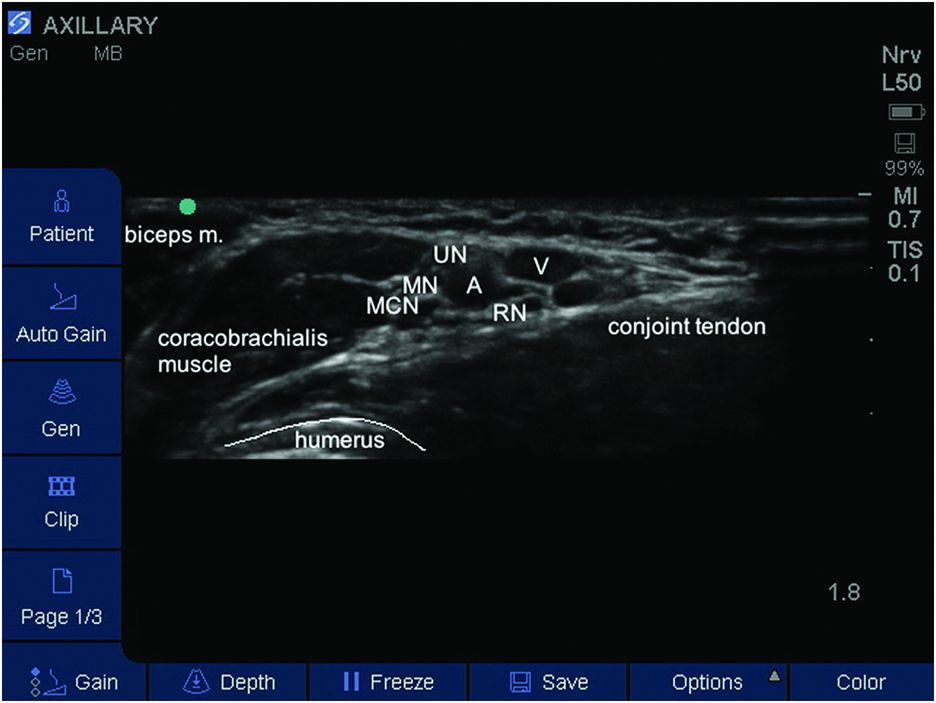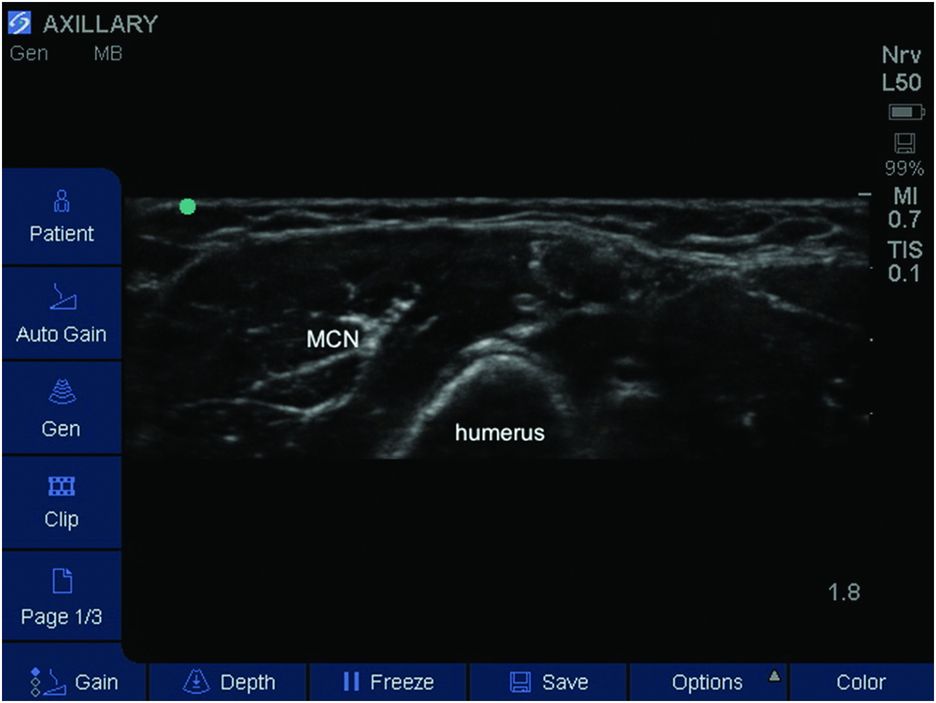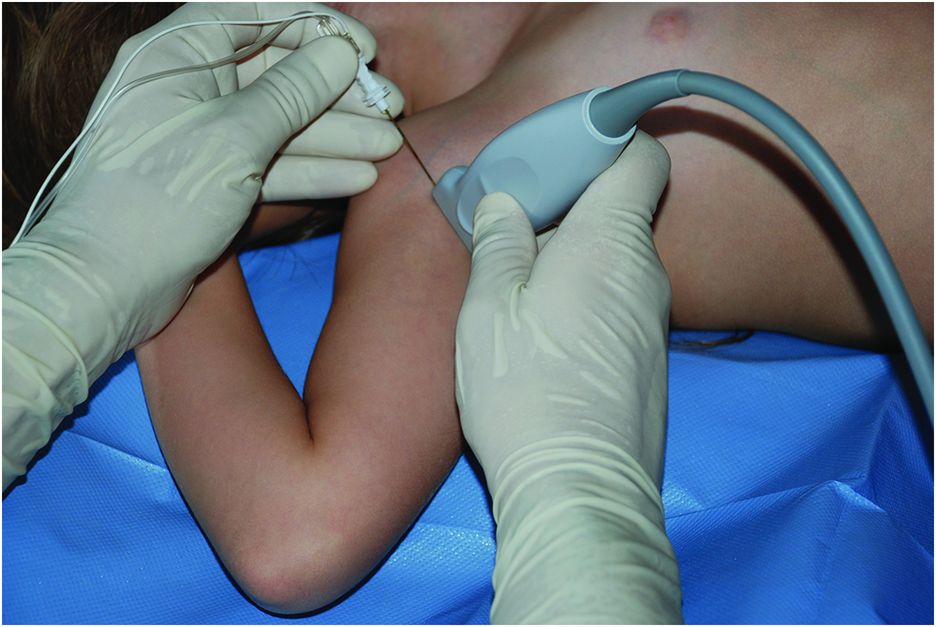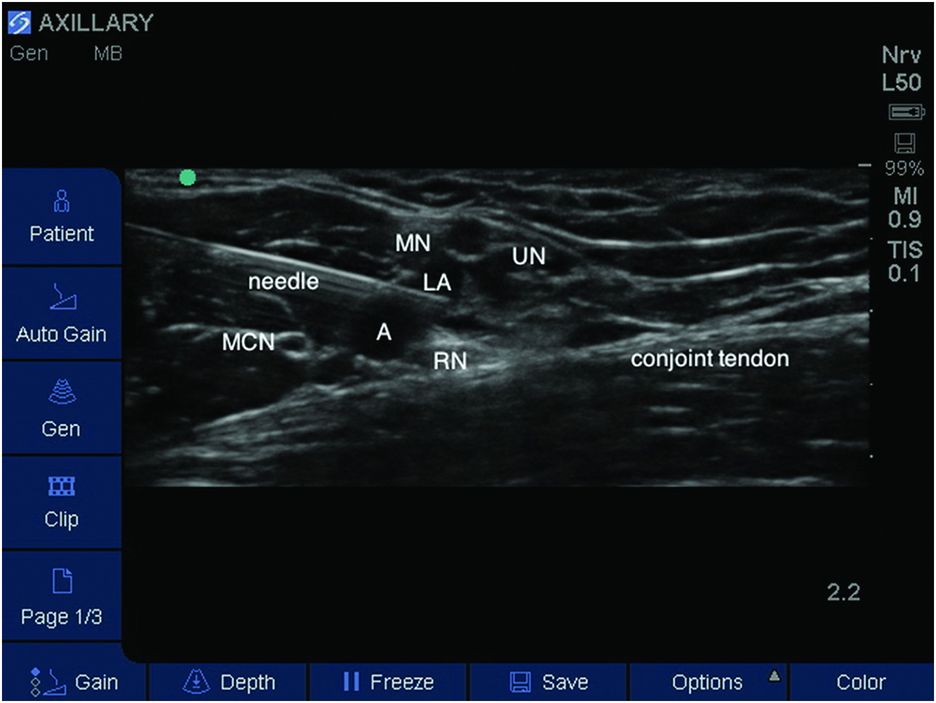Sonoanatomy for axillary brachial plexus block (AxBPB).

Labeled sonoanatomy for axillary brachial plexus block (AxBPB). A, axillary artery; MCN, musculocutaneous nerve; MN, median nerve; RN, radial nerve; UN, ulnar nerve; V, axillary vein.
The median nerve normally lies close to the axillary artery, usually found between the 9 and 12 o’clock positions. The median nerve has contributions from both the medial and lateral cords and may appear as two distinct entities visible in the axilla.
The ulnar nerve commonly lies between 1 and 4 o’clock in relation to the artery, and commonly sits between axillary artery and vein. Not infrequently the ulnar nerve is in very close relation to the axillary vein, which may envelope the nerve.
The radial nerve may be difficult to visualize; however, in the axilla it lies on the tendon of teres major between 6 o’clock and 4 o’clock on the artery. It is often seen just below the ulnar nerve.
The position of the musculocutaneous nerve is very variable. The musculocutaneous nerve usually leaves the brachial plexus just below the clavicle, and lies in a fascial plane between the coracobrachialis and the biceps muscles (Figure 7.3). Occasionally, the musculocutaneous nerve does not branch off before the axilla, in which case it is still part of the lateral cord and resides close to the median nerve at 9 o’clock on the artery (Figure 7.2).

Postion of musculocutaneous nerve (MCN) distal to axillary artery.
Variation in the axillary vasculature has been described in the literature with the prevalence of axillary artery variation ranging between 5 and 18% (Cadver et al., 2000). It is thought that axillary artery variability results from abnormal embryonic development of the limb bud vascular plexuses, which is of importance in performing the AxBPB.
Innervation of the surgical site in the upper limb may involve more than one component of the brachial plexus. Knowledge of the neural anatomy of the upper limb is imperative for understanding the nerves that need to be blocked. In clinical practice, blocking of all the components of the plexus is recommended because of inter-individual variation and overlap in sensory territories.
Landmarks
With the child in a supine position, the arm is abducted to 90 degrees, the shoulder externally rotated, and the elbow flexed to 90 degrees. The important surface landmarks are: the anterior axillary line medially, the posterior axillary line inferiorly, and the pectoralis major tendon superiorly (Figure 7.4). A high frequency linear ultrasound probe is placed on the skin of the axilla. The ultrasound probe should be oriented to obtain a transverse (axial) view of the underlying structures. Dynamic ultrasound probe movement proximally and distally allows identification of the relevant anatomy. The key structure to identify is the pulsating non-compressible axillary artery. The nerves can be found around the artery as described above.

Patient position and probe placement. In-plane needle technique.
Block performance
An in-plane or out-of-plane approach may be adopted utilizing a 22-gauge short bevel needle, usually 25–50 mm depending on the child’s size. The majority of clinicians opt for direct needle visualization using the in-plane technique (Chan et al. 2007), as this allows visualization of the needle tip throughout the procedure and of the spread of LA around the target nerves (Figure 7.5).

Needle insertion and local anesthetic (LA) placement. A, axillary artery; MCN, musculocutaneous nerve; MN, median nerve; RN, radial nerve; UN, ulnar nerve.
The choice of LA is dependent on desired onset and duration of block. Lidocaine 2% with epinephrine (1:200 000) has a rapid onset (5–15 min) and duration of approximately 3–4 hours. Bupivacaine/levobupivacaine 0.25% has slower onset (20–30 min) and a duration of 8–10 hours. The dose of LA used for children can be limited by the use of ultrasound (Amiri and Espander, 2010). There are no published data on the recommended LA total dose that should be used for AxBPB in the pediatric population. Common recommended volumes are 0.2–0.3 ml/kg. The use of very low dose LA in AxBPBs have been described for adult anesthesia (O’Donnell and Iohom, 2009; Ferraro et al., 2014).
Postoperative care
The principles of postoperative care for the AxBPB are similar to other peripheral nerve blocks. Many patients may have a shorter inpatient stay if the appropriate support for patient discharge following regional anesthesia is in place (Wedel et al., 1991). Care of the insensate limb is important, particularly in the pediatric population. Following discharge, an appropriate environment with optimal supervision from parents is required which can reduce risk of injury to the limb. Educating parents on the nature of the AxBPB, expected duration of block, and the importance of meticulous care of the insensate limb until full sensory and motor function has returned is paramount. The affected limb must be placed in a protective sling to avoid injury. Both oral and written information should be provided with details relevant to the block and contact information for the anesthesia team.









